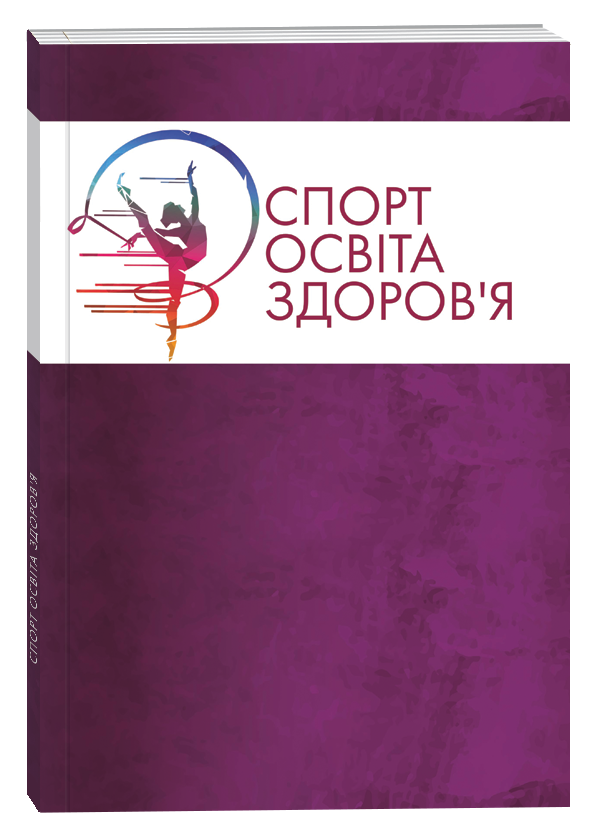MOTIVATIONAL FEATURES FOR ENGAGING IN PHYSICAL ACTIVITY AMONG OVERWEIGHT ADOLESCENT GIRLS
DOI:
https://doi.org/10.32782/sports-education/2025-2-2Keywords:
physical activity, motivation, body mass disorders, girls, adolescenceAbstract
Purpose. The study aims to determine the characteristics of motivation for physical activity among adolescent girls with body mass disorders. Methods. The research employed theoretical analysis of specialized scientific and methodological literature and documentary materials, pedagogical research methods, sociological methods (survey), and mathematical statistics methods. The study involved 24 twelve- year-old girls, seventh-grade students, who had body mass disorders. All participants lived in the same city and had similar living conditions, nutrition, financial status, and social background. The selection of participants was based on body mass index (BMI) indicators, which served as a criterion for forming the study group for further observation. Results. The survey results revealed key aspects of adolescent girls’ attitudes toward physical activity, as well as their emotional and motivational characteristics. Most of the girls indicated that their primary motives for engaging in physical activity were improving health, enhancing appearance, and socializing with peers. Parental and teacher recommendations had a lesser influence, highlighting the importance of an individualized approach to motivation. A significant portion of the girls reported that physical activity brought them joy, energy, and calmness. At the same time, some respondents experienced tension or fatigue, suggesting the need to optimize physical activity loads.The main reasons for avoiding physical activity were lack of time, fatigue, poor well-being, and insufficient interest in exercise. This underscores the need to adjust programs according to adolescents’ real capabilities and needs. Girls who regularly engaged in physical activity mostly noted a positive impact on their self-esteem, confirming the role of physical activity in fostering self-confidence. Only a small percentage of respondents indicated that their emotional state consistently led them to avoid physical activity, suggesting a need for additional psychological support for certain participants. Most respondents described their emotional state as stable or good, although some noted mood variability or tension, which could affect their overall motivation for exercise. The majority reported that physical activity improved their emotional state, though a portion of them indicated only a partial or no effect.
References
1. Андрєєва О.В., Максименко А.О. Сучасні підходи до корекції дефіциту маси тіла дівчат-підлітків засобами оздоровчого фітнесу. Спортивна медицина, фізична терапія та ерготерапія. 2020. № 2. С. 38–42.
2. Андрєєва О.В., Максименко А.О., Лишевська В.М. Сучасні підходи до використання фітнес-технологій як засобу корекції фізичного стану підлітків. Науковий часопис Національного педагогічного університету імені М П. Драгоманова. Серія 15 «Науково-педагогічні проблеми фізичної культури (фізична культура і спорт)». 2020. № 7 (127). С. 9–14. DOI: 10.31392/NPU-nc.series15.2020.7(127).01.
3. Жданова О.М., Чеховська Л.Я., Лужна М.Я., Стефанишин М.В. Корекція маси тіла дівчат підліткового віку засобами оздоровчого фітнесу. Науковий часопис Національного педагогічного університету імені М.П. Драгоманова. Серія «Науково-педагогічні проблеми фізичної культури (фізична культура і спорт)». 2023. Вип. 6 (166). С. 65–69. DOI: 10.31392/NPU-nc.series15.2023.6(166).13.
4. Максименко А., Андрєєва О., Благій В. Особливості ціннісних орієнтацій дівчат 12–13 років з різною масою тіла. Фізична культура, спорт та здоров’я нації. 2023. Вип. 15 (34). С. 37–46. DOI: 10.31652/2071-5285-2023-15(34)-37-46.
5. Марченко О.Ю., Цикало Л.С., Васецький І.А. Особливості мотивації до занять фізичною культурою і спортом хлопців та дівчат середнього шкільного віку. Науковий часопис Національного педагогічного університету імені М.П. Драгоманова. Серія «Науково-педагогічні проблеми фізичної культури (фізична культура і спорт)». 2021. Вип. 5K (134). С. 25–29.
6. Chen G., Chen J., Liu J., Hu Y., Liu Y. Relationship between body mass index and physical fitness of children and adolescents in Xinjiang, China: a cross- sectional study. BMC Public Health. 2022. Vol. 22, № 1. Р. 1680. DOI: 10.1186/s12889-022-14089-6.
7. Drosopoulou G., Sergentanis T.N., Mastorakos G., Vlachopapadopoulou E., Michalacos S., Tzavara C., … Tsitsika A. Psychosocial health of adolescents in relation to underweight, overweight/obese status: The EU NET ADB survey. European Journal of Public Health. 2021. Vol. 31, № 2. P. 379–384.
8. Yang F., Jiang Y. Adolescent Self-Control and Individual Physical and Mental Health in Adulthood: A Chinese Study. Frontiers in Psychology. 2022. Vol. 13. Article 850192. DOI: 10.3389/fpsyg.2022.850192.
9. Zeiler M., Philipp J., Truttmann S., Waldherr K., Wagner G., Karwautz A. Psychopathological symptoms and well-being in overweight and underweight adolescents: a network analysis. Nutrients. 2021. Vol. 13, № 11. Article 4096.
10. Zhu S.Q., Zhang Y.J. Analysis of behavioral risk factors for overweight and obesity among children and adolescents (7–17 years old) in China. Chinese Journal of Prevention and Control of Chronic Diseases. 2022. Vol. 30, № 07. P. 491–496. DOI: 10.16386/j.cjpccd.issn.1004-6194.2022.07.003.
11. Zhu Z., Tang Y., Zhuang J. et al. Physical activity, screen viewing time, and overweight/obesity among Chinese children and adolescents: an update from the 2017 physical activity and fitness in China-the youth study. BMC Public Health. 2019. Vol. 19. Article 197. DOI: 10.1186/s12889-019-6515-9.


